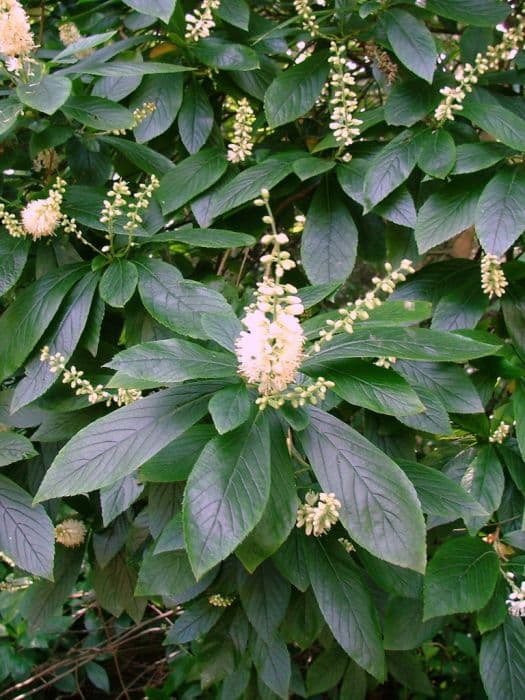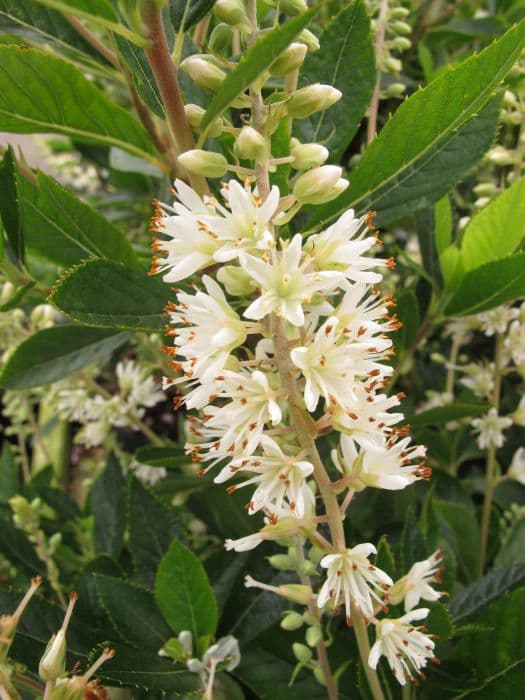Sweet Pepperbush Clethra alnifolia 'Ruby Spice'

ABOUT
The Ruby Spice is a visually appealing plant characterized by its lush green foliage and strikingly fragrant, deep pink flowers. The leaves are oval-shaped with a pointed tip and serrated edges, exhibiting a bright green color that contrasts beautifully with the blooms. These flowers are the hallmark of the Ruby Spice, appearing in slender, upright clusters known as racemes that offer a striking visual and olfactory experience during their blooming season. The blossoms are a rich pink hue, a rarer color in this plant variety, which tends to deepen as they age, rather than fade. These colorful and aromatic attributes combine to make the Ruby Spice a favorite among gardeners looking to add both visual impact and pleasant scents to their landscapes. The flowers also attract pollinators such as bees and butterflies, adding an additional level of liveliness to the garden when the plant is in bloom. Overall, the Ruby Spice is a versatile and decorative plant that adds a touch of elegance to any garden setting.
About this plant
 Names
NamesFamily
Clethraceae
Synonyms
Ruby Spice Summersweet, Ruby Spice Sweet Pepperbush, Ruby Spice Clethra
Common names
Clethra alnifolia 'Ruby Spice'
 Toxicity
ToxicityTo humans
Sweet Pepperbush 'Ruby Spice' is not commonly known to be toxic to humans. However, like with any plant material, individuals could potentially have an allergic reaction or experience stomach upset if they ingest parts of the plant, especially in large quantities. It is always recommended to exercise caution and avoid ingesting plants that are not specifically meant for consumption.
To pets
Sweet Pepperbush 'Ruby Spice' is not commonly known to be toxic to pets. However, it is always best to prevent pets from ingesting plants. The ingestion of any plant material may cause gastrointestinal upset such as vomiting or diarrhea in pets. If a pet shows any signs of illness after ingesting plant material, it is advised to consult a veterinarian.
 Characteristics
CharacteristicsLife cycle
Perennials
Foliage type
Deciduous
Color of leaves
Green
Flower color
Pink
Height
4-6 feet [1.2-1.8 meters]
Spread
3-5 feet [0.9-1.5 meters]
Plant type
Shrub
Hardiness zones
4-9
Native area
North America
Benefits
 General Benefits
General Benefits- Attractive Fragrance: Clethra alnifolia 'Ruby Spice' emits a sweet, spicy fragrance that is particularly strong in the summertime.
- Vibrant Flowers: Produces deep pink to ruby red flowers that add a splash of color to the landscape.
- Bee and Butterfly Magnet: The flowers attract beneficial pollinators, such as bees and butterflies, which help pollinate other plants in the garden.
- Wildlife Friendly: The plant provides nectar for pollinators and its seeds can serve as food for birds.
- Four-Season Interest: Offers year-round visual interest with flowers in summer, colorful fall foliage, and exfoliating bark in winter.
- Adaptability: Summer Sweet, as it's commonly known, is adaptable to a range of soil types, though it prefers moist, well-drained soil.
- Shade Tolerance: It can grow in full sun to partial shade, making it a versatile choice for various garden locations.
- Native Plant: As a native species, it supports local ecosystems and is typically easier to care for than non-native plants.
- Compact Size: Typically remains a manageable size (3-6 feet tall), which is ideal for smaller gardens or residential landscaping.
- Low Maintenance: Summer Sweet requires minimal maintenance once established, needing only occasional pruning to maintain its shape and remove any dead wood.
 Medical Properties
Medical PropertiesThis plant is not used for medical purposes.
 Air-purifying Qualities
Air-purifying QualitiesThis plant is not specifically known for air purifying qualities.
 Other Uses
Other Uses- Wildlife Habitat: Ruby Spice provides shelter and nesting sites for birds and small mammals due to its dense foliage.
- Natural Dye: The flowers and leaves can be used to create natural dyes for fabric, with the potential for shades of yellow or green.
- Perfumery: The fragrant flowers of Ruby Spice can be used in the making of natural perfumes or potpourri due to their pleasant scent.
- Culinary Garnish: Although not widely known for culinary uses, the flowers can be used as an edible garnish for desserts and salads.
- Arts and Crafts: The distinctive seed heads can be used in dried flower arrangements or as part of craft projects.
- Photography Subject: The vibrant flowers and lush foliage make it an excellent subject for botanical photography.
- Educational Tool: Ruby Spice can be utilized in educational settings to teach about pollination as it attracts a variety of pollinators.
- Seasonal Decoration: The colorful autumn foliage and persistent seed capsules provide material for fall decorations.
- Living Fences: Planted in a row, Ruby Spice can act as a visually appealing, living fence that provides privacy and noise reduction.
- Soil Stabilization: It can be used in landscaping to prevent soil erosion on slopes due to its spreading root system.
Interesting Facts
 Feng Shui
Feng ShuiThe Summersweet is not used in Feng Shui practice.
 Zodiac Sign Compitability
Zodiac Sign CompitabilityThe Summersweet is not used in astrology practice.
 Plant Symbolism
Plant Symbolism- Attraction: Clethra alnifolia 'Ruby Spice', commonly known as the Ruby Spice Summersweet, is often associated with attraction due to its fragrant pink flowers that attract various pollinators.
- Sweetness: The common name "Summersweet" refers to the plant's sweet-smelling blooms, symbolizing the sweetness of life and pleasant experiences.
- Renewal: As a deciduous shrub that blooms in mid to late summer, Summersweet often symbolizes renewal and the continuation of life cycles.
- Adaptability: Due to the plant's adaptability to a range of soil conditions, including wet and clay soils, it symbolizes flexibility and the ability to thrive in various environments.
- Purity: The colors of its blossoms, ranging from white to deep pink, can symbolize purity, innocence, and beauty in the natural world.
 Water
WaterFor the Summersweet 'Ruby Spice', water thoroughly once a week, allowing the soil to dry out slightly between waterings. In the growing season, it may require about 1-1.5 gallons per plant each week, depending on the weather conditions, with more frequent watering during prolonged dry spells. In the fall and winter months, reduce watering as the plant goes dormant and its water requirements decrease. Adjust the amount based on rainfall, making sure not to overwater, as Summersweet prefers well-drained soil and does not tolerate waterlogged conditions.
 Light
LightSummersweet 'Ruby Spice' thrives in partial shade to full sun but prefers a spot that offers some afternoon shade in hotter climates. The ideal location provides bright, indirect light for most of the day, protecting the plant from the harshest midday sun which can scorch the leaves.
 Temperature
TemperatureSummersweet 'Ruby Spice' is hardy and can tolerate a temperature range from about 0°F to 85°F, but it grows best in temperatures between 60°F and 75°F. Extreme temperatures below 0°F or above 85°F could stress the plant or cause damage.
 Pruning
PruningPrune Summersweet 'Ruby Spice' in late winter or early spring to maintain its shape and remove any dead or damaged branches. This plant benefits from pruning to encourage bushier growth and improve air circulation. The best time for pruning is before new growth starts, typically in late February to early March.
 Cleaning
CleaningAs needed
 Soil
SoilSummersweet 'Ruby Spice' prefers a well-draining, acidic soil mix with a pH range of 4.5 to 6.5. A combination of pine bark, peat moss, and perlite or sand can provide the ideal structure and acidity. Amend with organic matter to improve fertility.
 Repotting
RepottingSummersweet 'Ruby Spice' does not require frequent repotting; it can be repotted every 2-3 years or when it outgrows its current container. Early spring before new growth starts is the best time for repotting.
 Humidity & Misting
Humidity & MistingSummersweet 'Ruby Spice' thrives in moderate to high humidity levels, typically ranging from 50% to 70%. It can adapt to outdoor humidity fluctuations but appreciates consistently moist air.
 Suitable locations
Suitable locationsIndoor
Provide bright light, acid soil, and regular watering for indoor Summersweet.
Outdoor
Plant in partial shade, use acidic soil, and keep soil moist for outdoor Summersweet.
Hardiness zone
4-9 USDA
 Life cycle
Life cycleThe life of the 'Ruby Spice' Summersweet begins with seed germination in spring after a period of cold stratification, which breaks the seed's dormancy. Following germination, the seedling emerges and establishes a root system while growing into a small shrub. Once mature, the Summersweet enters a phase of vegetative growth each spring, marked by the development of its distinctive glossy green leaves and woody stems. During mid to late summer, 'Ruby Spice' enters its reproductive stage, producing fragrant, pink to ruby-red flower spikes that attract pollinators. After pollination, the flowers develop into brown seed capsules in the fall, which release seeds for dispersal. Throughout the winter, the plant enters dormancy, conserving energy and preparing for the next cycle of growth in the spring.
 Propogation
PropogationPropogation time
Summer to Early Fall
Propogation: The most popular method of propagating Clethra alnifolia 'Ruby Spice', commonly known as summersweet, involves taking semi-ripe cuttings during late summer. To achieve the best results, one should cut healthy stems of about 4 to 6 inches (10 to 15 cm) that contain several leaf nodes. The lower leaves should be removed and the cut end can be dipped into a rooting hormone powder to encourage root development. The prepared cutting should then be placed into a pot with moistened potting soil or a mix of peat and perlite. To maintain humidity, the pot can be covered with a plastic bag or placed in a propagator. It is crucial to keep the soil consistently moist but not waterlogged and to provide the cuttings with indirect light until rooting occurs, which is typically within a few weeks. After root growth is confirmed, the new summersweet plants can be gradually acclimatized to outdoor conditions before being planted in their final location.

